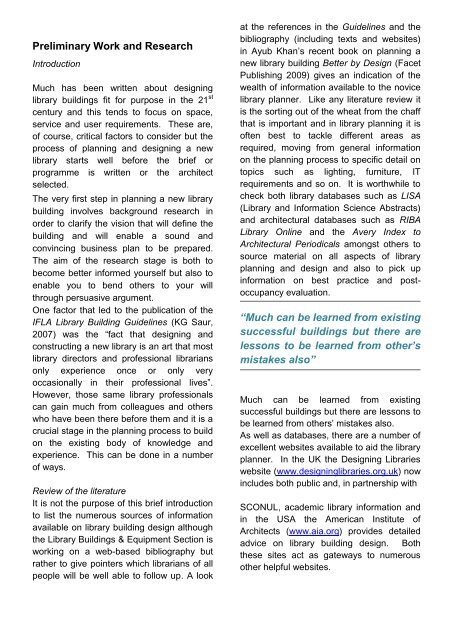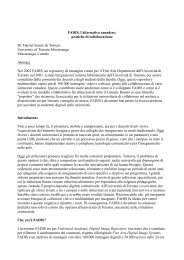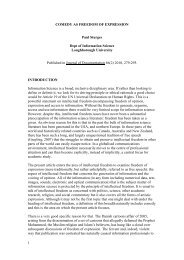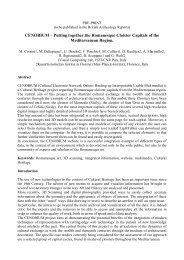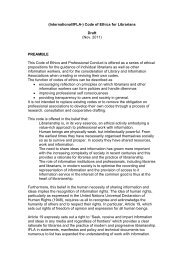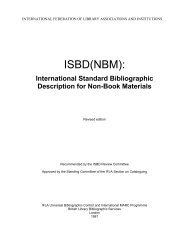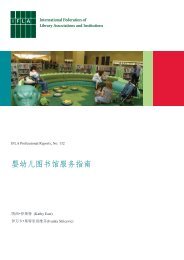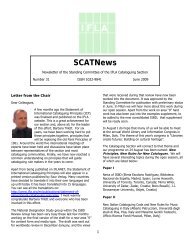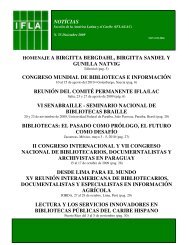Library Buildings and Equipment Section Key Issues in ... - IFLA
Library Buildings and Equipment Section Key Issues in ... - IFLA
Library Buildings and Equipment Section Key Issues in ... - IFLA
Create successful ePaper yourself
Turn your PDF publications into a flip-book with our unique Google optimized e-Paper software.
Prelim<strong>in</strong>ary Work <strong>and</strong> Research<br />
Introduction<br />
Much has been written about design<strong>in</strong>g<br />
library build<strong>in</strong>gs fit for purpose <strong>in</strong> the 21 st<br />
century <strong>and</strong> this tends to focus on space,<br />
service <strong>and</strong> user requirements. These are,<br />
of course, critical factors to consider but the<br />
process of plann<strong>in</strong>g <strong>and</strong> design<strong>in</strong>g a new<br />
library starts well before the brief or<br />
programme is written or the architect<br />
selected.<br />
The very first step <strong>in</strong> plann<strong>in</strong>g a new library<br />
build<strong>in</strong>g <strong>in</strong>volves background research <strong>in</strong><br />
order to clarify the vision that will def<strong>in</strong>e the<br />
build<strong>in</strong>g <strong>and</strong> will enable a sound <strong>and</strong><br />
conv<strong>in</strong>c<strong>in</strong>g bus<strong>in</strong>ess plan to be prepared.<br />
The aim of the research stage is both to<br />
become better <strong>in</strong>formed yourself but also to<br />
enable you to bend others to your will<br />
through persuasive argument.<br />
One factor that led to the publication of the<br />
<strong>IFLA</strong> <strong>Library</strong> Build<strong>in</strong>g Guidel<strong>in</strong>es (KG Saur,<br />
2007) was the “fact that design<strong>in</strong>g <strong>and</strong><br />
construct<strong>in</strong>g a new library is an art that most<br />
library directors <strong>and</strong> professional librarians<br />
only experience once or only very<br />
occasionally <strong>in</strong> their professional lives”.<br />
However, those same library professionals<br />
can ga<strong>in</strong> much from colleagues <strong>and</strong> others<br />
who have been there before them <strong>and</strong> it is a<br />
crucial stage <strong>in</strong> the plann<strong>in</strong>g process to build<br />
on the exist<strong>in</strong>g body of knowledge <strong>and</strong><br />
experience. This can be done <strong>in</strong> a number<br />
of ways.<br />
Review of the literature<br />
It is not the purpose of this brief <strong>in</strong>troduction<br />
to list the numerous sources of <strong>in</strong>formation<br />
available on library build<strong>in</strong>g design although<br />
the <strong>Library</strong> <strong>Build<strong>in</strong>gs</strong> & <strong>Equipment</strong> <strong>Section</strong> is<br />
work<strong>in</strong>g on a web-based bibliography but<br />
rather to give po<strong>in</strong>ters which librarians of all<br />
people will be well able to follow up. A look<br />
at the references <strong>in</strong> the Guidel<strong>in</strong>es <strong>and</strong> the<br />
bibliography (<strong>in</strong>clud<strong>in</strong>g texts <strong>and</strong> websites)<br />
<strong>in</strong> Ayub Khan‟s recent book on plann<strong>in</strong>g a<br />
new library build<strong>in</strong>g Better by Design (Facet<br />
Publish<strong>in</strong>g 2009) gives an <strong>in</strong>dication of the<br />
wealth of <strong>in</strong>formation available to the novice<br />
library planner. Like any literature review it<br />
is the sort<strong>in</strong>g out of the wheat from the chaff<br />
that is important <strong>and</strong> <strong>in</strong> library plann<strong>in</strong>g it is<br />
often best to tackle different areas as<br />
required, mov<strong>in</strong>g from general <strong>in</strong>formation<br />
on the plann<strong>in</strong>g process to specific detail on<br />
topics such as light<strong>in</strong>g, furniture, IT<br />
requirements <strong>and</strong> so on. It is worthwhile to<br />
check both library databases such as LISA<br />
(<strong>Library</strong> <strong>and</strong> Information Science Abstracts)<br />
<strong>and</strong> architectural databases such as RIBA<br />
<strong>Library</strong> Onl<strong>in</strong>e <strong>and</strong> the Avery Index to<br />
Architectural Periodicals amongst others to<br />
source material on all aspects of library<br />
plann<strong>in</strong>g <strong>and</strong> design <strong>and</strong> also to pick up<br />
<strong>in</strong>formation on best practice <strong>and</strong> postoccupancy<br />
evaluation.<br />
“Much can be learned from exist<strong>in</strong>g<br />
successful build<strong>in</strong>gs but there are<br />
lessons to be learned from other’s<br />
mistakes also”<br />
Much can be learned from exist<strong>in</strong>g<br />
successful build<strong>in</strong>gs but there are lessons to<br />
be learned from others‟ mistakes also.<br />
As well as databases, there are a number of<br />
excellent websites available to aid the library<br />
planner. In the UK the Design<strong>in</strong>g Libraries<br />
website (www.design<strong>in</strong>glibraries.org.uk) now<br />
<strong>in</strong>cludes both public <strong>and</strong>, <strong>in</strong> partnership with<br />
SCONUL, academic library <strong>in</strong>formation <strong>and</strong><br />
<strong>in</strong> the USA the American Institute of<br />
Architects (www.aia.org) provides detailed<br />
advice on library build<strong>in</strong>g design. Both<br />
these sites act as gateways to numerous<br />
other helpful websites.


